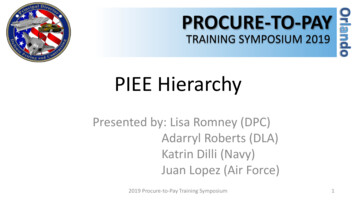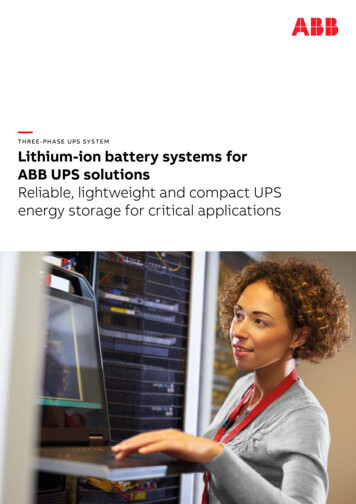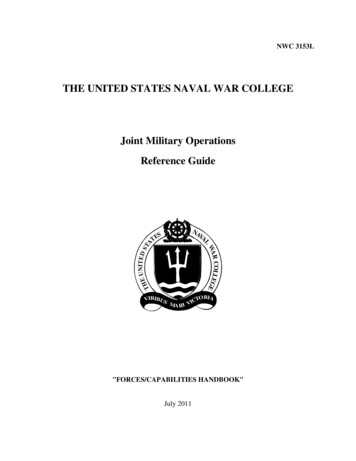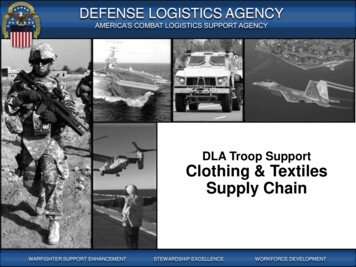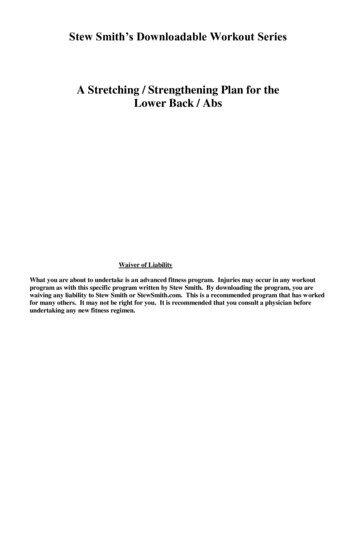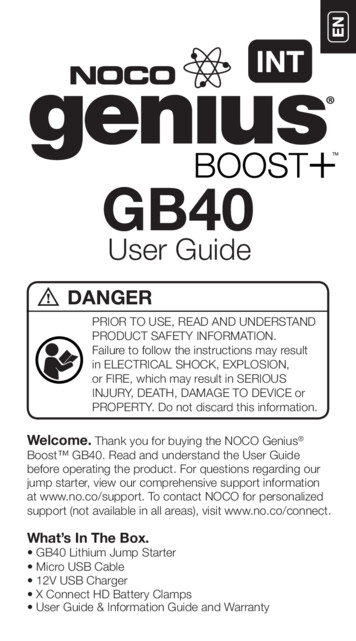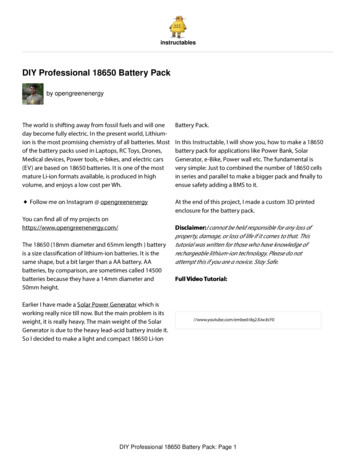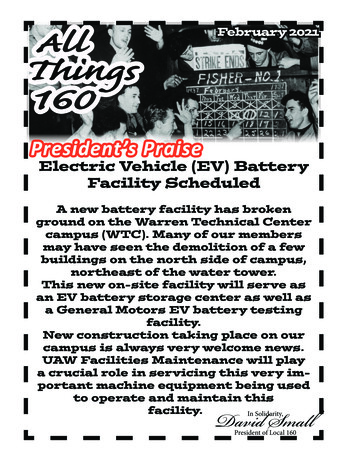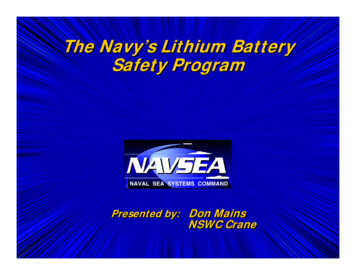
Transcription
The Navy’s Lithium BatterySafety ProgramPresented by: Don MainsNSWC Crane
Lithium Battery SafetyProgramOutline of Presentation Introduction and Background on Lithium Batteries History of the Lithium Battery Safety Program(LBSP) Process for Lithium Battery Safety Approval LBSP and WSESRB Relationship Conclusion and Questions
Lithium Battery SafetyProgramLithiumLithium Facts:Facts: ElementElement withwith AtomicAtomic NumberNumber 33 LightestLightest AlkaliAlkali MetalMetal (r 0.53(r 0.53 g/cmg/cm33)) Silvery,Silvery, MetallicMetallic SolidSolid atat RoomRoom TempTemp VeryVery HighHigh ThermalThermal andand ElectricalElectricalConductivityConductivity HighestHighest SpecificSpecific HeatHeat ofof anyanySolidSolid ElementElement SourceSource –– SaltsSalts && HydratesHydratesALKALIALKALI assiumRubidiumRubidiumCesiumCesiumFranciumFrancium MeltsMelts atat 180.5180.5 CC (357.0(357.0 F)F)ReactsReacts withwith WaterWaterBurnsBurns inin AirAirVeryVery HighHigh ElectrochemicalElectrochemicalPotentialPotential ExtremelyExtremely MobileMobile 1 1 IonsIons6.94AtomicWeight
Lithium Battery SafetyProgramLithium Uses and ApplicationsNON-ENERGETIC: LithiumLithium CitrateCitrate UsedUsed inin thethe OriginalOriginal 7-Up7-Up SodaSoda (Original(Original Name,Name, 1929, 1929, waswas “Bib-Label“Bib-Label LithiatedLithiated Lemon-LimeLemon-Lime Soda”)Soda”) LithiumLithium CarbonateCarbonate UsedUsed AsAs Anti-DepressantAnti-Depressant DrugDrug LithiumLithium CompoundsCompounds UsedUsed inin thethe ProductionProduction ofof AluminumAluminum fromfromOxidesOxides (Enhances(Enhances conductivityconductivity forfor electrolysiselectrolysis ofof AlAl22OO33)) Li-AlLi-Al AlloysAlloys UsedUsed inin LightweightLightweight StructuralStructural ApplicationsApplications (Aircraft)(Aircraft) LithiumLithium OxidesOxides andand FluoridesFluorides UsedUsed inin GlassesGlasses andand CeramicsCeramics (Mt.(Mt.PalomarPalomar Telescope)Telescope) LithiumLithium StearateStearate UsedUsed inin All-PurposeAll-Purpose andand High-TemperatureHigh-TemperatureLubricantLubricant
Lithium Battery SafetyProgramLithium Uses and Applications (cont.)ENERGETIC: LithiumLithium MetalMetal UsedUsed AsAs aa Heat-transferHeat-transfer MediumMedium LithiumLithium MetalMetal UsedUsed DirectlyDirectly AsAs aa FuelFuel (Mk(Mk 5050 Propulsion)Propulsion) LithiumLithium MetalMetal (and(and Alloys)Alloys) UsedUsed AsAs BatteryBattery AnodeAnode MaterialMaterial OtherOther EmergingEmerging TechnologiesTechnologies -- LithiumLithium PerchloratePerchlorateOxygenOxygen Storage,Storage, LithiumLithium Semi-cellSemi-cell FuelFuel Cells,Cells, etc.etc.
Lithium Battery SafetyProgramQ.What is a lithium battery?A.One or more electrochemical cells (containing lithium asa metal, alloy or compound) electrically connected in anappropriate series/parallel arrangement to provide therequired operating voltage and current levels including, ifany, monitors controls and other ancillary components(fuses, diodes), case terminals and markingsLinden & Reddy, Handbook of Batteries, Third EditionA.A self-contained chemical reactor (containing lithium asa metal, alloy or compound) that is capable oftransforming chemical energy into electrical energy ondemandLevy & Bro, Battery Hazards and Accident Prevention
Lithium Battery SafetyProgramLithium Cell Types Used by the Navy Primary (Non-rechargeable)––ActiveReserve Liquid electrolyte Thermal Secondary (Rechargeable)
Lithium Battery SafetyProgramLithium Cell Chemistries Used by the NavyLi/FeS2,Li/V22O55 Solid Cathode -- Li/MnO22, Li/CFx,x,2, Liquid Cathode -- Li/SOCl22, Li/SO22, Li/SO22Cl22 Lithium metal anode Lithium alloy anode Lithium ion anode
Lithium Battery SafetyProgramLithium Cell Designs Used by the NavyBobbinSpiral WindLinden & Reddy, Handbook of Batteries, Third Edition
Lithium Battery SafetyProgramLithium Cell Designs Used by the NavyBipolar Stacked PlatesASB-MSBASB-MSB ThermalThermal BatteriesBatteries Guide/EPTGuide/EPT TechnicalTechnical GuideGuide
Lithium Battery SafetyProgramLithium Cell Designs Used by the NavyCoinPrismaticLinden & Reddy, Handbook of Batteries, Third Edition
Lithium Battery SafetyProgramLithium Cell Sizes Button cell (0.01 Ah) 2/32/3 AA (0.60 Ah) 1/31/3 C (0.86 Ah) 1/21/2 AA (0.95 Ah) C (5.4 Ah) D (7.2 Ah) DD (16.5 Ah) 2/32/3 A (1.20 Ah) AA (1.90 Ah) A (2.8 Ah) 9V (1.20 Ah) 2/52/5 C (2.50 Ah) Specialty design cell(2,200 Ah) 10,000 Ah prismatic cell
Lithium Battery SafetyProgramWhere Lithium Batteries Are Used in the Navy Communication Radios Mines Mine Countermeasures Electronic & Acoustic Decoys Locator Beacons Sonobuoys Memory Back-Up Deep Ocean Sensors Emergency Signal Devices Transponders Missile Guidance & Control Telemetry Systems Laser Detection Devices Small UUV Propulsion Night Vision Goggles Laptop Computers Expendable Training Devices
Lithium Battery SafetyProgramCommon Safety Devices for LithiumBatteries Include: Electrical fuses Thermal fuses Diodes (charging and bypass) Voltage monitors FETs Vent structures Fuseable separators
Lithium Battery SafetyProgramLithium Battery Stored Chemical Energy Controlled release of this energy provideselectrical power in the form of current andvoltage Uncontrolled release of this energy can resultin fire, exposure of toxic materials, shrapnel,high pressure events, and any combinationthereof
Lithium Battery SafetyProgramOrigin of the Navy’s Lithium Battery SafetyProgram First marketed in early 1970, primarily for military applications Featured substantial increases in both gravimetric andvolumetric energy density Commercial and military facilities explored safetycharacteristics in the lab in conjunction with fielding systems Seven personal injuries were reported during the period 1976through 1983, including one death
Lithium Battery SafetyProgram NAVSEAINST 9310.1A of 11 March 1982 NAVSEANOTE 9310 of 11 June 1985 NAVSEAINST 9310.1B of 13 June 1991 Technical Manual for Batteries, Navy LithiumSafety Program And Procedures S9310-AQSAF-010 of 20 July 1988
Lithium Battery SafetyProgramS9310-AQ-SAF-010 IntroductionSelection and salEmergency response proceduresSafety and performance tests for certificationPass fail criteriaSafety
Lithium Battery SafetyProgramSAFETY TESTING (Primary Batteries) Constant current discharge & reversal Short circuit High temperature Charging Electrical safety device
Lithium Battery SafetyProgram
Lithium Battery SafetyProgramSAFETY TESTING (Thermal Batteries) Unactivated: Environmental Activated––––High Rate DischargeThermal AbuseOpen CircuitCharging
Lithium Battery SafetyProgram
Lithium Battery SafetyProgram
Lithium Battery SafetyProgramSAFETY TESTING (Reserve Batteries) Unactivated– Environmental– High Temperature Activated––––Constant Current Discharge and ReversalShort CircuitOpen CircuitHigh Temperature Activation
Lithium Battery SafetyProgramSAFETY TESTING (Rechargeable Batteries) Short Circuit Overcharge/Discharge Overdischarge/Charge High Temperature Electrical Safety Device
Lithium Battery SafetyProgram
Lithium Battery SafetyProgramREQUIREMENTS FOR APPROVAL Request letter Safety data package Test report Safety evaluation letter Draft approval letter
Lithium Battery SafetyProgramREQUEST LETTER Defines– System– Platform– Action desired Submitted on letter head Signed
Lithium Battery SafetyProgramSAFETY DATA PACKAGE Battery/Cell Description–––––––––Battery manufacturerModel Number and/or Part NumberElectrical descriptionOperating lifePhysical dimensions and descriptionMarking indicating battery chemistryCell and/or battery yield pressureMaterial Safety Data SheetsCell failure mode
Lithium Battery SafetyProgramSAFETY DATA PACKAGE (CONT.) Lithium battery-powered equipment Model number and/or Part Number and device nameDiagram of the system's overall mechanical interfacesBattery housing/container, strength, and free volumeBattery installationSafety features or venting mechanismsCurrent drainBlock diagram of systemElectrical schematic
Lithium Battery SafetyProgramSAFETY DATA PACKAGE (CONT.) Logistics–– LogisticsLogistics andand operationaloperational useuse–– PackagingPackaging–– StorageStorage facilitiesfacilities–– TransportationTransportation methodsmethods–– DisposalDisposal informationinformation–– BatteryBattery changeoutchangeout replacementreplacement planplan Functional, environmental and safety tests performed todate Proposed safety testing program plan
Lithium Battery SafetyProgramPASS-FAIL CRITERIA An inability of the lithium batteries or lithiumbattery-powered equipment to meet the "passing"criteria does not necessarily result in an automaticrejection of the equipment for service use.
Lithium Battery SafetyProgramUNIT CRITERIA Land: Unit has a fail safe vent system to keep pressurebelow 50 percent of the yield pressure of the unit. Surface Ship: Same as above, except no external fire orflame. Aircraft: Same as above, except the use of liquid cathodelithium cells and batteries is strongly discouraged. Submarine: Total containment. Internal pressure shallstay below 50 percent of the yield pressure of the batterycompartment.
Lithium Battery SafetyProgramUNIT CRITERIA (Cont.) Relief Mechanism Criteria– If pressure relief mechanisms are provided in theunit, they must prevent the pressure from reachinga peak value of 50% of the yield pressure of theunit.– If pressure relief mechanisms are not provided, therecorded peak pressure in any test must not exceed50% of the yield pressure of the unit to beconsidered safe.
Lithium Battery SafetyProgramUNIT CRITERIA (Cont.) Batteries must not vent in response to theElectrical Safety Device Test Reaction from the battery shall not adverselyaffect the safety of the unit
Lithium Battery SafetyProgramSAFETY EVALUATION LETTER Contains the results of the review of the datasubmitted– Request letter–––Safety data packageTest reportAny other related information Provides justification for recommendationfor approval based on technical evaluation ofall test and design data Restrictions and limitations
Lithium Battery SafetyProgramAPPROVAL LETTER Issued from NOSSA States conditions and limitations for use
Lithium Battery SafetyProgramTIME TABLE Three weeks to two months after receipt of allinformation
Lithium Battery SafetyProgramLithium Battery Safety Program TaskingTransmitsTransmits DataData PackagePackage&& RequestsRequests ReviewReviewRefersRefers DataDataPackagePackage toto aaTechnicalTechnical ExpertExpertCarderockCode 644Sponsor/Program OfficeNOSSACode N311Cross-Lab VerificationWhen AppropriateReceivesReceives OfficialOfficialResponseResponse fromfrom NOSSANOSSASingleSingle POCPOC IssuesIssuesApprovalApproval LettersLettersCraneCode 609Laboratories Conduct Safety Tests, Review Data Packagesand Recommend Action
Lithium Battery SafetyProgramImpacts of Lithium Battery Safety Program Lithium battery database Single POC for battery-related inquiries Design changes Alternate non-lithium power sourcesAdded safety devicesRevised battery designs
Lithium Battery SafetyProgramRelationship to WSESRB LBSP supports WSESRB charter by providing asource of data for hazard assessments on systemsthat include lithium batteries LBSP is independent of WSESRB because manyapplications that include lithium batteries are notsubject to WSESRB review LBSP is similar in function to the SSSTRP and FISTRP
Lithium Battery SafetyProgramWSESRBWSESRB OnlyBothLBSPLBSP OnlyAegisAFDReconnaissance UUVsNimitzArtillery Fuzes w/batteriesCSEL RadioJSHIPMissile SystemsIntegrated Navigation SonarSensor2.75 Rocket SystemLMRSArmy/USMC Comm DevicesBFTTTorpedoesExpendable Mobile ASW TrainingTargetAnti Tank WeaponCountermeasure UUVsVersatile Exercise Mine
Lithium Battery SafetyProgramConclusionThe concept of a lithium battery encompasses a widevariety of specific characteristicsThe Navy has an excellent safety record with lithiumbattery use, and this is the process by which we havemet and will continue to maintain this recordLBSPs primary function is to minimize risk to personneland platforms while allowing the use of lithium batteriesto advance our military capabilities
Lithium Battery SafetyProgramFOR MORE INFORMATION CONTACT:Don MainsJulie 5457 faxMains don@crane.navy.milMains @nswccd.navy.mil
Program Lithium Battery Safety Program Lithium Uses and ApplicationsLithium Uses and Applications NON-ENERGETIC: Lithium Citrate Used in the Original 7-Up Soda (Original Name, 1929, was “Bib-Label Lithiated Lemon-Lime Soda”) Lithium Carbonate Used As Anti-Depressant Drug
